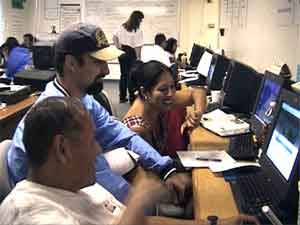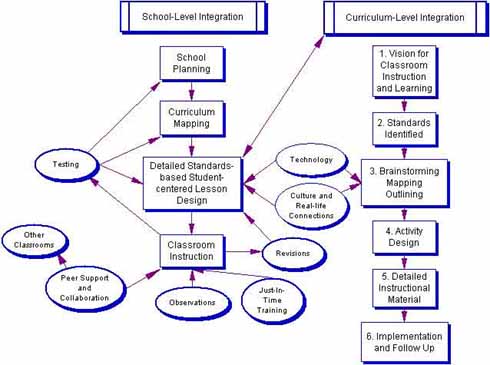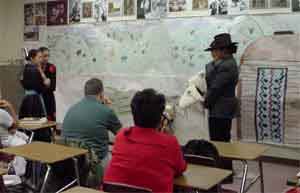|
|
| Vol 13|No 6|February-March|2004 | |
|
Please feel free to e-mail this article to a friend, a principal, a parent, a colleague, a teacher librarian, a college professor, a poet, a magician, a vendor, an artist, a juggler, a student, a news reporter or anyone you think might enjoy it. Other transmissions and duplications not permitted. (See copyright statement below).
Technology Skills vs. Curriculum Development Even though we believe curriculum should take a leading role in integration, we have learned how easy it is to let technology unintentionally remain the focus of training. Teachers can have a great time learning web authoring, digital video, or digital imaging, but much more is required for actual change in the classroom. Ironically, it seems the better job we do exciting teachers with new technology, the harder it is to focus on curriculum, standards, and good instructional design. During training, we have seen teachers share ideas and develop new and exciting activities that integrate technology only to find in too many cases that the lessons were never used or not used well. Very often we found that key elements of the lesson were missing or incomplete. Insufficient details in the lesson resulted in teachers attempting a lesson that did not go off very well, or they realized that they were not prepared to try something new. In too many cases, not feeling prepared led them to teach the old lessons and change nothing. Who wants to look incompetent? And some teachers later felt that their new lesson had little connection to the existing curriculum. Clearly, we needed a new approach to technology integration.
Preparing for last year’s summer program, we committed to having curriculum be the primary focus and outcome of our training no matter how much we had to reduce the focus on technology to make that happen. I am not suggesting that this is an either/or decision, but finding the right balance is a challenge. I am suggesting that we decided that we were going to demonstrate our commitment to student achievement through standards-based, classroom-oriented lessons, and this goal was going to lead the way. This is the best thing that we have done for instructional technology.
Finding the Balance As we began to develop a plan to address the problems we faced in previous years, an improved strategy began to emerge:
Demonstrating these priorities in our materials and processes helped us find a better balance of technology training and curriculum development, and helped us see more results in the classroom this year. Training Materials Our participants often described a more interactive, student-centered learning environment, but, again, transferring these visions into actual classroom change has been a challenge. We do not have a lot of time to teach constructivism, problem-based, or project-based learning, so we instead began identifying elements of the lesson that would make that kind of lesson come to life and succeed in the classroom. These elements were identified by observing problems with previous lessons, and from examining successful student-centered strategies. Once lesson elements such as rotation strategies, student roles, ground rules, and plan Bs, were identified, we designed our instructional material and templates around them. We learned that incomplete lessons never challenged our teachers to think through various interactions in a student-centered classroom. Conversely, detailed instructional materials were showing them a new way to teach and making it more likely that they would use them in the classroom. And we learned that the flow and process of curriculum development proved as important as the materials. Development Process The deeper we took teachers into curriculum development, the more apparent it became that we were challenging their thinking and beliefs about teaching, and the more apparent it became that they were involved in a very personal journey. Paying more attention to their journey, it became easier to understand why we had previously failed to engage some of our teachers in change, or why we had sometimes lost them along the way. Change does not happen all at once, but to make important pieces of a lesson come together for a successful learning experience requires us to encourage teachers to think through important details and interactions without having them shut down because they are overwhelmed.
Another challenge is the lack of time available for professional development and change. Accordingly, another critical balance that we have to achieve every day is trying to move teachers as quickly as possible through this process while respecting the pace demanded by quality and the assimilation of change. Though this is a constant and evolving learning experience, a curriculum development process has emerged that is helping us to find a critical and effective balance: 1. Articulate a vision. The first step in our process asks teachers to articulate a clear vision for their classrooms. This vision includes very specific details about what they would like to see their students doing in a high-achieving learning environment. Most teachers are describing a more interactive, student-centered classroom. Describing specifics about their learning environment helps us later to enter a meaningful conversation about how technology might help support that environment. But not yet! 2. Identify standards and learning goals. Evidence of data-driven decision making is more prevalent today than it was when we began. This works to our benefit. We do not proceed until standards are considered in terms of need and an overall instructional framework. It is also helpful to identify teaching strategies that will be used to meet standards. This step adds important meaning for engaging teachers in the process. At this point, we have a vision of where we want to go, we have identified a starting point, and now it is time to show them an instructional solution to close the gap. 3. Brainstorm and map lessons. When teachers sense that they are engaging in a practical classroom-based solution and when they are working with equally committed peers, an incredible amount of creative energy can be unleashed. In a process of expanding and narrowing ideas, ample opportunities exist to discuss a supporting role for technology while considering meaningful, real-life connections to learning goals. Discussing technology here makes much more sense to teachers. 4. Choose an activity design. Depending on how the lesson has been defined thus far, specifics are identified and outlined to define the various interactions and activities in a new learning environment . 5. Create detailed instructional material for the lesson. Lacking detailed instructional material, very little change can be expected in the classroom. In the process working on material to support student-centered strategies, among other things, teachers sort out management issues, logistics, assessment, and various interactions. For some teachers, designing a more interactive classroom requires them to think through a new level teacher-student, student-student, student-information, and student-technology interactions. Here is where many teachers begin to see themselves and their students in new roles. Here is where they gain confidence and become willing to try something new in their classroom. 6. Implementation and follow up. Most teachers welcome follow up support when implementing their lesson. In addition to expected revisions that must be made, they very often realize that they have made some assumptions about their students taking on new responsibilities for their learning. This is a step that can begin to institutionalize this process, but our efforts have been more individualized. Because each of our trainers is responsible for 25-40 schools, we have traditionally involved only one or two teachers at each school. More recently, however, we have begun to work with grade-level teachers with the hope of establishing more peer support. Conclusion Curriculum development can be hard work compared to playing with the latest techno-gadgets. However, with the right leadership and encouragement, most teachers are willing to roll up their sleeves and engage in this meaningful work. Designing new lessons can script innovative learning experiences while paving the way for logical choices about how resources like technology might support those experiences. The role of technology will shift just as carefully designed lesson plans shift the roles of teacher and student. |
|
Back to February Cover
Credits: The photographs were shot by Jamie McKenzie . Copyright Policy: Materials published in From Now On may be duplicated in hard copy format if unchanged in format and content for educational, nonprofit school district and university use only and may also be sent from person to person by email. This copyright statement must be included. All other uses, transmissions and duplications are prohibited unless permission is granted expressly. Showing these pages remotely through frames is not permitted. FNO is applying for formal copyright registration for articles. Unauthorized abridgements are illegal.
|
 From Now On
From Now On


